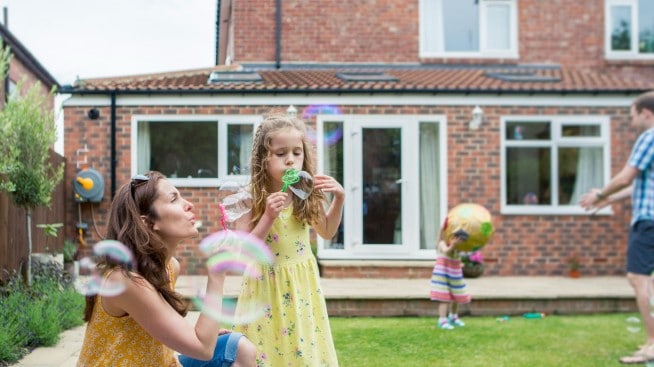A guide to green remodeling and renovations

There are many reasons you may want to remodel or renovate your home. For example, you may want to breathe some new life into a space with an updated look. Alternatively, you could be hoping to improve your home’s functionality. If you’re exploring ways to incorporate sustainability and a “green” mentality into your homeownership journey, you may be curious about ways to fix up your home in an environmentally friendly way. To better understand your options, let’s break down what green remodeling is, its pros and cons, and various methods homeowners may use to “go green” with their home’s updates.
What is green remodeling?
Green remodeling essentially means making changes to the structure of your home in a way that considers the environment. This means using eco-friendly materials, putting an emphasis on energy efficiency, minimizing waste and remodeling your home to make it greener. Green renovations, which are more about the restoration of your home than structural reimagining, are another way to fix up your home in a sustainable, environmentally conscious way. While the formal designation of “green home” requires Energy Star or LEED certification, these eco-friendly updates may be a step in a greener direction. Whether you’re remodeling or renovating, there are plenty of reasons you may want to pursue sustainable home improvement, as well as some considerations to keep in mind before making decisions about your updates.
Pros and cons of green remodeling and renovations
Most decisions come with unique pros and cons, and taking a green approach to remodeling and renovations is no different. While the potential pros, such as energy savings, are hard to argue with, there are also potential drawbacks, like higher initial costs, you may want to be aware of. Keep the following considerations in mind while exploring how to make your home more sustainable:
Pros of green home improvement
- Energy efficiency: Updating your home with energy-efficient appliances may reduce your energy consumption and lower your monthly utility bills.
- Environmental impact: Choosing sustainable materials and energy-efficient appliances could lower your carbon footprint, which is a win for the environment.
- Improved air quality indoors: The nontoxic building materials used for many green remodeling and renovation projects means a healthier environment for your loved ones to live in.
- Potential increase in home value: As the world becomes more environmentally conscious, energy-efficient homes are becoming more appealing to buyers.
- Long-term cost savings: Reducing energy and water consumption typically leads to long-term savings on utility bills.
- Energy-efficient mortgages (EEM): In some cases, you may be able to fold energy-efficient home improvements into your mortgage payments with an energy-efficient mortgage if you’re planning on improving the home you’re purchasing or refinancing. Chase does not offer this product.
Cons of green home improvement
- Higher initial costs and longer payback period: Sustainable materials and energy-efficient appliances may cost more than less environmentally friendly options despite the potential for long-term savings. Because of the extra expense, it may take longer to recoup that initial investment.
- Limited product choices: Depending on your location you may find that there are limited options for sustainable materials and energy-efficient appliances.
- Complex implementation: Some green building practices may require specialized contractors, which may mean a longer search for the right expert and a higher fee.
How can green remodeling and renovations make your home more sustainable?
If you’re wondering how to make your home more sustainable, there are quite a few changes you can implement — and they don’t have to happen all at once. You can start as small as installing smart home systems and work your way up to more serious undertakings, like installing solar panels.
- Invest in insultation, windows and doors: Good insulation will help keep your home warm in the cold months and cool when it’s hot, which could reduce your energy consumption and, as a bonus, lower your bills. Similarly, double-pane windows and energy-efficient doors help regulate indoor temperatures.
- Water conservation: Consider installing low-flow toilets, showerheads and faucets to reduce your water usage.
- Look into smart home technologies: The programming features of smart home systems allow homeowners to conveniently manage their energy usage from any location.
- Choose sustainable materials and upgrade your appliances: Making eco-friendly choices where materials and appliances are concerned is one way to make your house greener. Look for local, recyclable and sustainable materials when possible, and purchase appliances that reduce water and energy consumption. This can make everyday tasks like laundry and washing dishes more sustainable.
- Green landscaping: Local plants often require less watering than alternatives, making them a solid choice for people looking to conserve water.
- LED lighting: LED lights tend to last longer and use less energy than incandescent bulbs.
- Install solar panels: Solar panels help you generate renewable energy, and depending on your location, you may find there are tax credits, subsidies and rebates to help you offset the cost.
In summary
Using an eco-friendly approach to fixing up your home or making changes that make it more energy-efficient can reduce your carbon footprint and even save you money in the long run. While green remodeling and renovations may involve higher initial costs, some homeowners will find that the benefits outweigh that initial investment. If you’re looking to upgrade your home to make it greener, consider speaking with a professional to help you decide where to start. Every home and homeowner is different and they may be able to provide guidance regarding your specific needs.
Green remodeling FAQs
1. What’s the difference between renovating and remodeling?
Renovations are generally focused on restoring elements of a home, while remodeling refers to more drastic changes to a space. Think knocking down walls to create a more open living space.
2. Why is green remodeling important?
Going green in any area of your life helps to protect the environment by conserving energy, water, and other materials and resources, and green remodeling is one way to bring this consciousness into the home.
3. How does green remodeling benefit me?
Green remodeling may benefit you by reducing your long-term energy and water costs and could potentially increase your home’s value.



